

Are you wondering if I made an error by calling Google Sheets a “CRM”? No, I didn’t.
You can set up a CRM using Google Sheets effectively.
We know that Google Sheets lets you do whatever you want, however you want, as it can be customized to suit your needs. Yes, it’s a basic tool, but it can work wonderfully, especially if you are a small business or a budding startup founder. You just need to know how to make the most out of it. And I’ll tell you how.
What is a Google Sheets CRM?
Although Google Sheets has popularly been known as a spreadsheet tool, it can also function as a CRM if you play your cards well. You just need to follow some steps to set up Google Sheets as a CRM, and it’s an easy ride from there.
Google Sheets offers several benefits, including real-time collaboration, easy third-party integrations, data analysis, and reporting. If you’re looking for a cost-effective and customisable solution for managing your customer relationships, then using Google Sheets as a CRM is the perfect choice.
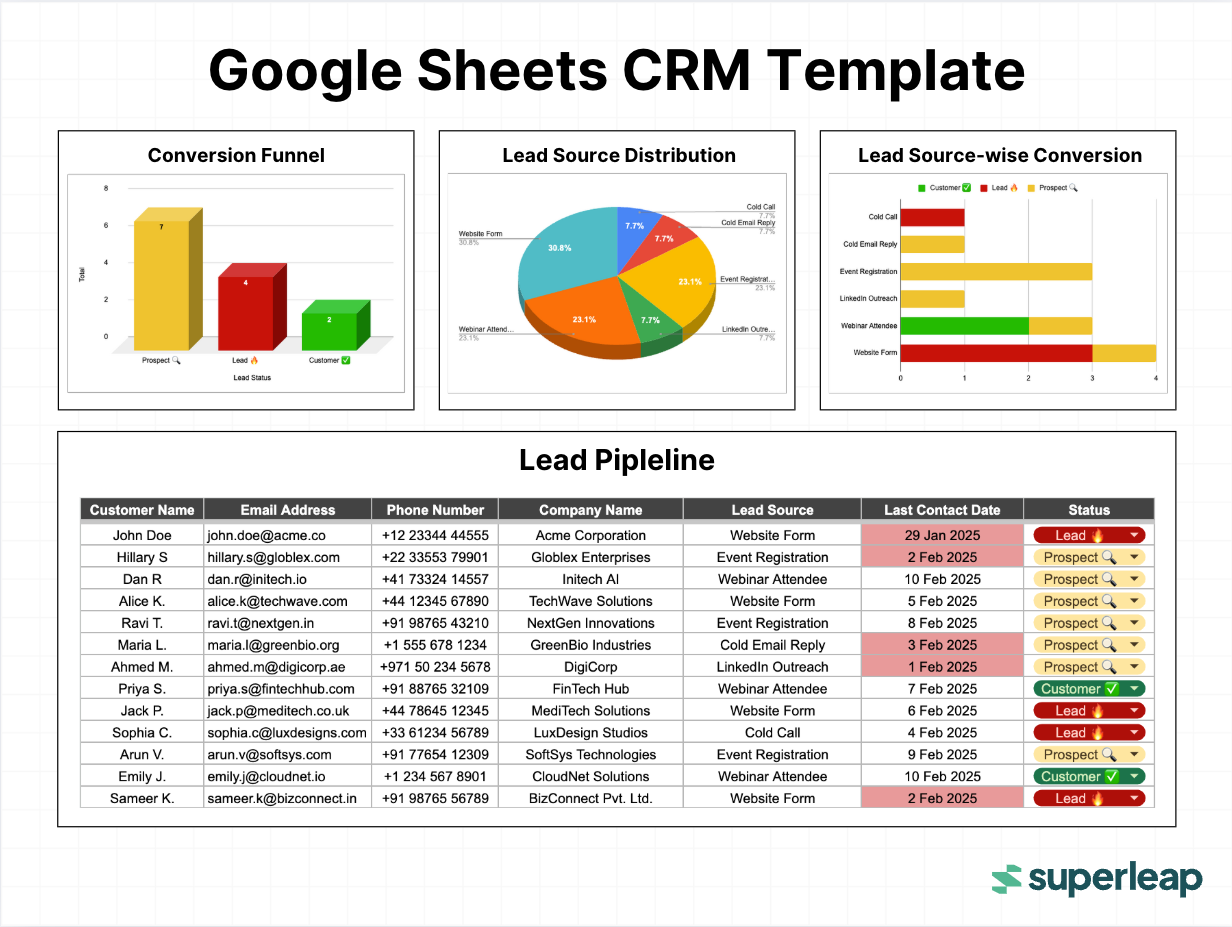
How to implement a Google Sheets CRM?
Step 1: Create a new spreadsheet
First, open Google Sheets and create a new spreadsheet. You can name the sheet something relevant like "CRM."
Step 2: Define your database
Your CRM needs to contain relevant customer information, so decide on the data fields that are important to your business. Each of these fields will become a column in your spreadsheet.
These data fields could include the following:
- Customer Name
- Email Address
- Phone Number
- Company Name
- Lead Source (How did they find you?)
- Last Contact Date
- Status (e.g., "Prospect," "Customer," "Under Negotiation")
- Notes (For additional details like preferences, important conversations, or upcoming follow-ups)
- Next Action (e.g., follow-up email, phone call)
Please note that you can add any field that is relevant to your business, and it is not limited to what I have mentioned above.
Step 3: Add or import data
Now is the time to accurately input the current pipeline data. This can either be done manually (for a limited number of contacts) or through email. You can only import data via email if you’ve kept your prospect’s data in your email contacts.
Step 4: Add data validation rules
Data validation allows you to control the data that your CRM users put into cells, thereby maintaining consistency and preventing errors or typos.
For example, for the "Status" column, you can create a dropdown menu with options like "Prospect," "Customer," and "Lead," so you can easily categorize and filter your customers.
Here’s how you can create a dropdown:
- Select the cells you want to add to the dropdown
- Go to Data > Data Validation in the top menu
- Click on “Add Rule”
- Under "Criteria," enter the options (e.g., Prospect, Customer, Lead) in your desired order
- You can also select colors for each option. Mark prospects in yellow, customers in green, and use red for leads as they require urgent follow-ups.
- Click “Done” to save this rule
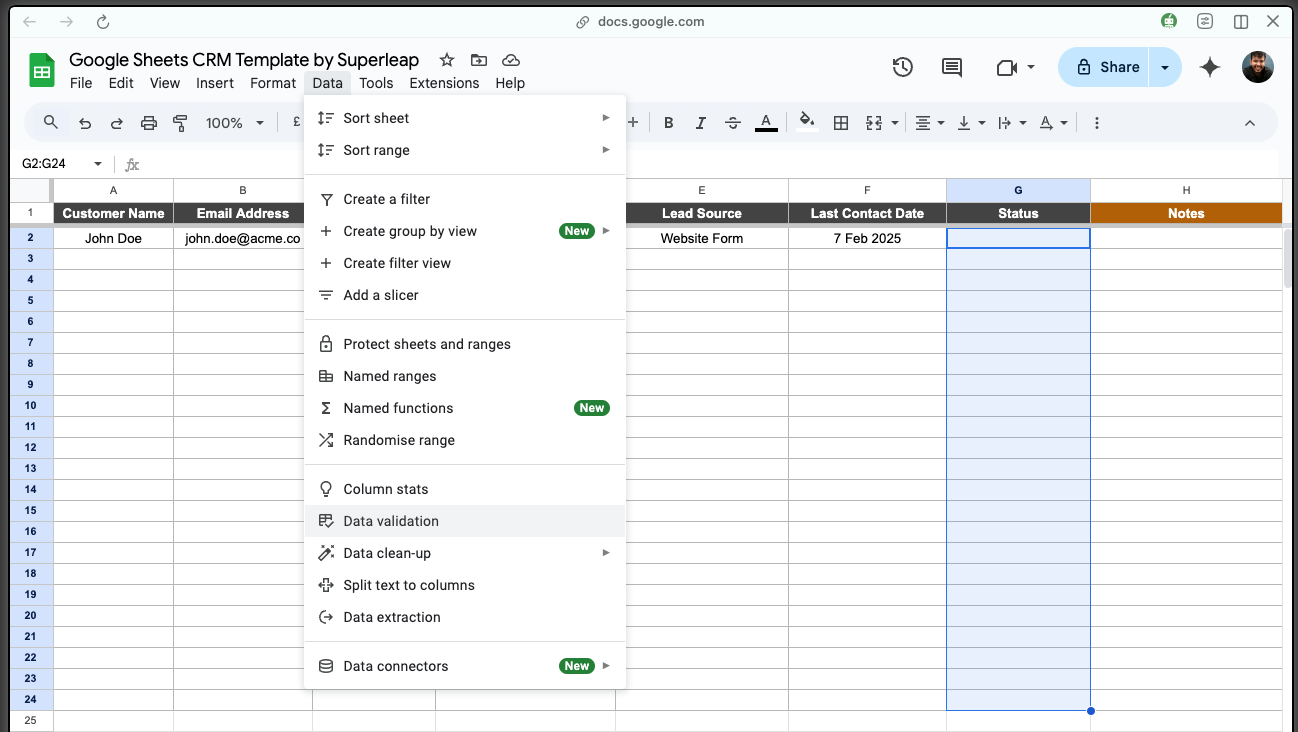
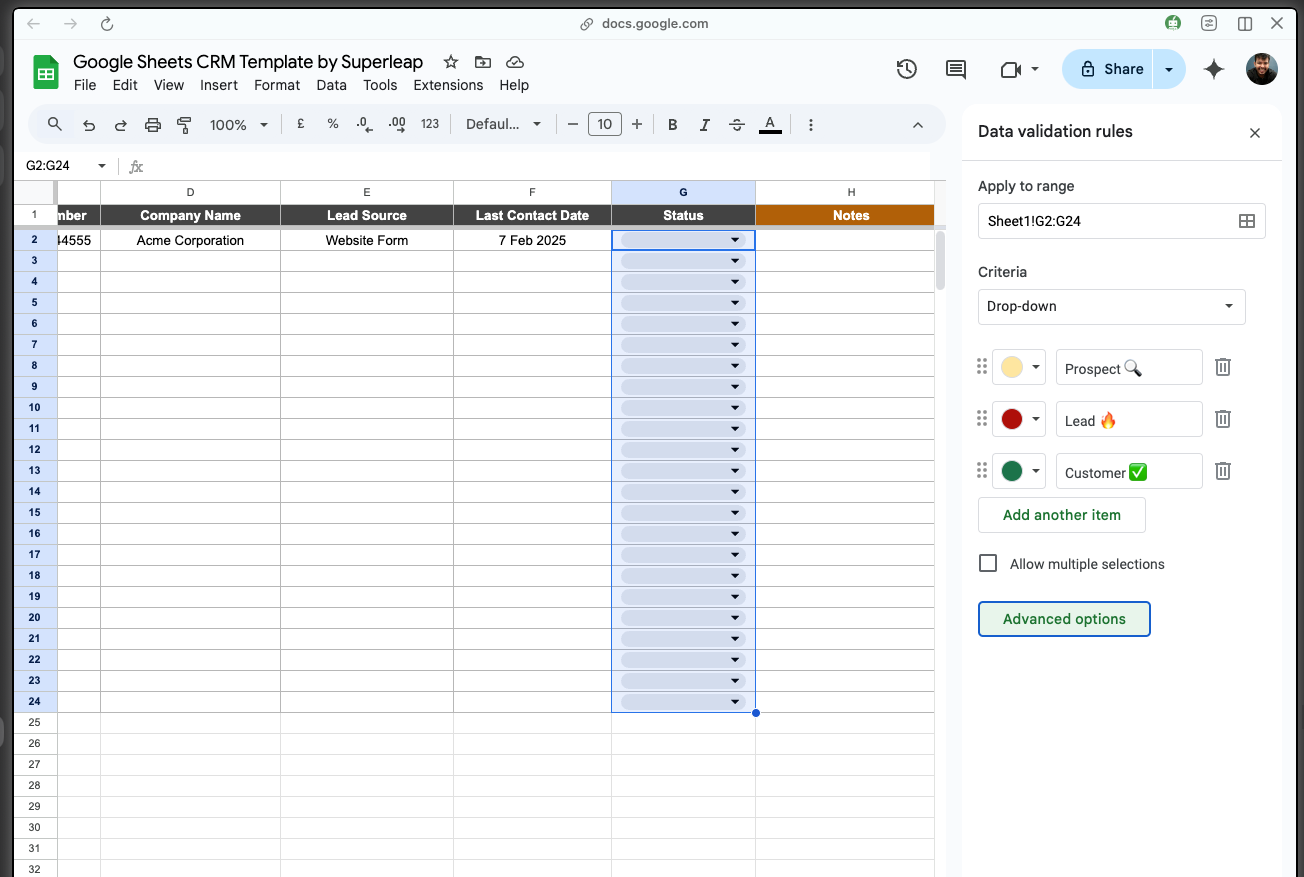
Step 5: Use conditional formatting
Conditional formatting allows you to visually distinguish different statuses or priorities, which makes the CRM easier to navigate. For instance, you could mark follow-up reminders for leads that were not contacted for a week.
- Select the “Last Contact Date” range
- Go to Format > Conditional formatting
- Set the conditions that if "date is before" and “in the past week”, the cell colour should be red
- Click “Done” to save this conditional formatting

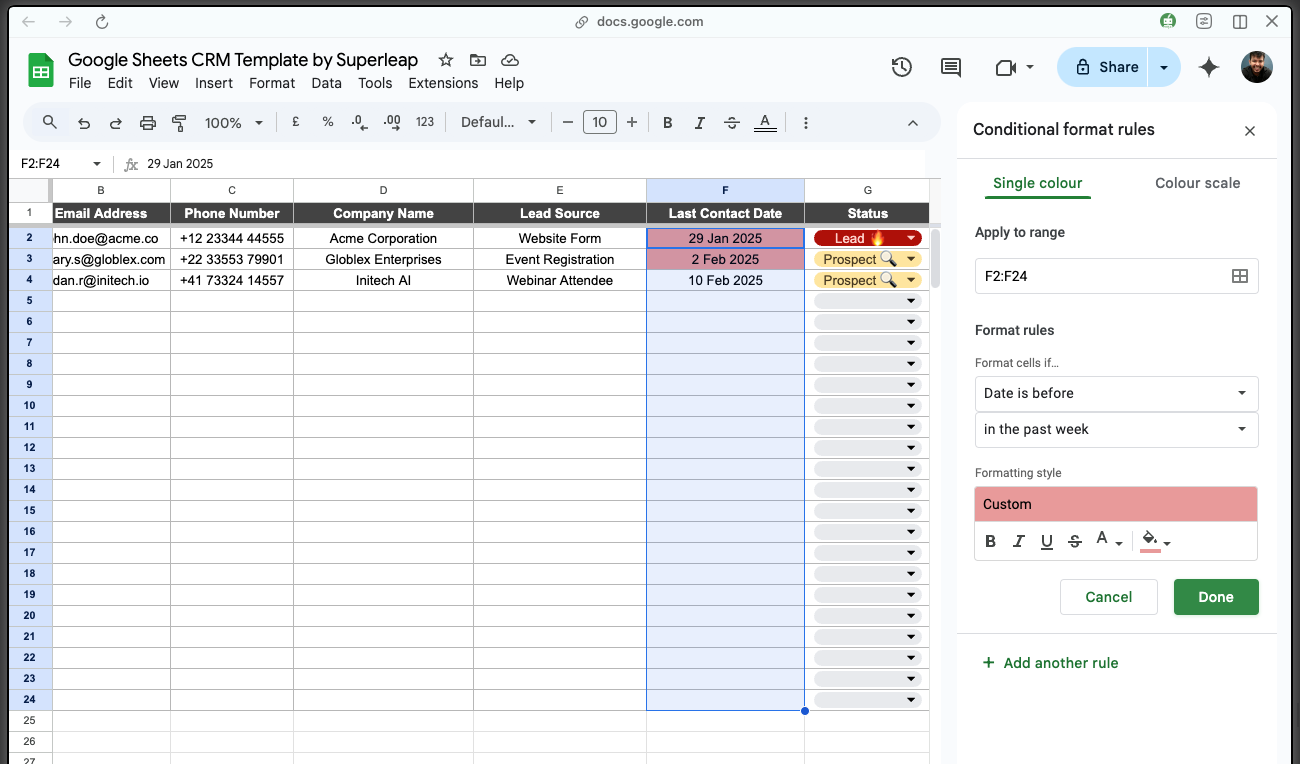
Step 6: Automate with Google Sheets features
Google Sheets come with certain built-in features that help automate and manage your CRM. Some of these are:
- Filters: Add filters to your columns to easily sort by customer status, last contact date, or any other criteria.
- Google Forms: If you're collecting customer data online (e.g., from your website), you can link a Google Form to your Google Sheets CRM.
The steps to do this are:
- Create a Google Form
- Add fields like name, email, phone, etc.
- Link the responses to your CRM sheet
- Every new entry gets updated automatically, thereby eliminating the need for manual data entry
- Email reminders: Google Sheets and Google Calendar can collectively be used to create reminders for follow-ups with customers.
The steps to do this are:
- After you make the follow-ups sheet, include a column titled “Follow-up date.”
- Sync it with Google Calendar using Google Apps Script
- Set up email notifications for when a follow-up date approaches
- Custom menus: Using Google Apps Script, you can add custom menus to your Google Sheets CRM. This will allow you to quickly access common tasks like adding new leads or generating reports, thereby streamlining your workflows and saving time on routine tasks.
Step 7: Secure your data
Since your Google Sheets CRM contains sensitive information about customers, it's your responsibility to ensure that it is protected. The following measures can be used for the same:
- Use protected ranges to prevent accidental edits by collaborators.
- Share the sheet only with team members who need access using the share button in the top-right corner.
- You can set permissions to view, comment, or edit depending on the role of the person you're sharing with.
Step 8: Integrate with other tools
Connect your Google Sheets CRM to other apps, such as email services, customer support platforms, or marketing tools, to keep everything in sync.
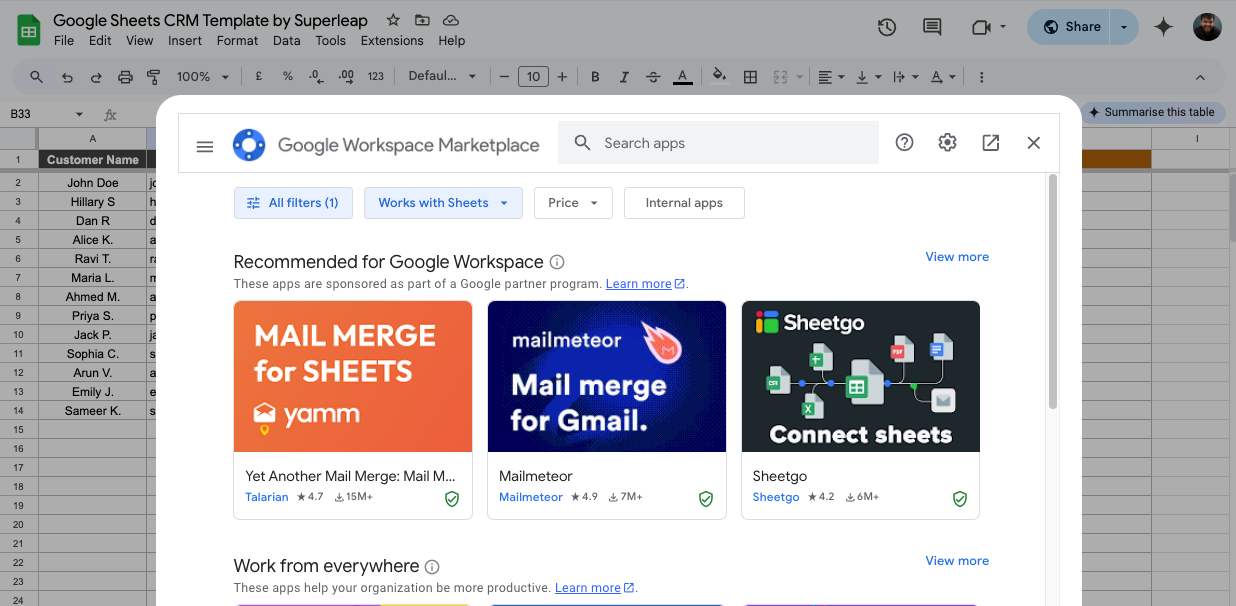
What are the benefits of using Google Sheets as a CRM?
- Cost-effective: Well, Google Sheets is literally a free tool. If you’re a small business owner, using Google Sheets as a CRM is going to make your life easier, and you don’t even have to get a subscription. Feels illegal? Well, it’s not.
- Easy to set up: Google Sheets’ intuitive interface and ready-to-use templates allow businesses to set up a CRM quickly and easily even without much technical knowledge.
- Easy to customize: In Google Sheets, you’re free to add or modify formulas, add new columns, and set data validation rules and formatting rules to suit your requirements, thereby making customization quick and easy.
- Real-time collaboration: As Google Sheets supports real-time collaboration, members of the team can access and update the CRM simultaneously. This enhances communication and coordination among team members as everyone has access to real-time updated information.
- Integrates well with other tools: Because of add-ons and APIs, Google Sheets integrates well with other marketing and communication tools, which in turn helps centralize customer data.
- Data analysis and reporting: Google Sheets offers good tools for data analysis and reporting. Features like pivot tables allow you to produce detailed reports containing insightful information about audience behavior and sales trends.
What are the drawbacks of using Google Sheets as a CRM?
Although using Google Sheets as a CRM is a good option for small businesses or startups, things can get tricky as businesses expand. Here’s why:
- More prone to human errors: Since most of the data that goes on Google Sheets is entered manually, it is more prone to errors. A CRM software, on the other hand, automates such tasks, thereby limiting the chances of human errors.
- Limited scalability: When your customer base grows, it can become difficult to manage large amounts of data using Google Sheets. Too many rows, columns, and complex formulas can slow down performance. Since Google Sheets lacks built-in automation for handling large numbers of customer interactions, it also becomes difficult to track.
- Lacks features that advanced CRMs offer: A CRM comes with several features like built-in email automation, pipeline tracking, lead scoring, workflow automation, etc. Google Sheets doesn’t offer these features.
- Lacks robust security and privacy features: Within a Google Sheets CRM, it’s easy for multiple users to overwrite or accidentally delete important data. There’s also a lack of access control as to who can view or edit certain data.
- Time-consuming customization process: Setting up Google Sheets as a CRM requires you to manually structure everything. This includes creating column headers, designing drop-down menus, and implementing conditional formatting, among other things. All these tasks are time-consuming.
- Limited opportunities for collaboration: Collaborative editing on Google Sheets tends to work well for smaller teams. However, as businesses expand and their teams become larger, issues in terms of managing access and other permissions will arise. An all-in-one CRM is a better option when this happens.
- Limited tools for reporting and analytics: Google Sheets offers basic tools for reporting and analytics, unlike a CRM, which has advanced tools for these purposes.
How can you be productive using Google Sheets as a CRM?
- Use a good template
- Customise the database to match your requirements
- Automate repetitive tasks
- Make use of conditional formatting
- Regularly perform data backup and cleanups
- Leverage Google Sheets add-ons like mail merge, Supermetrics, etc.
- Use charts and pivot tables in Google Sheets to create visual reports and dashboards
- Train your team
Download the Google Sheets CRM ⬇️
FAQs
Heading text
Nunc sed faucibus bibendum feugiat sed interdum. Ipsum egestas condimentum mi massa. In tincidunt pharetra consectetur sed duis facilisis metus. Etiam egestas in nec sed et. Quis lobortis at sit dictum eget nibh tortor commodo cursus.
Odio felis sagittis, morbi feugiat tortor vitae feugiat fusce aliquet. Nam elementum urna nisi aliquet erat dolor enim. Ornare id morbi eget ipsum. Aliquam senectus neque ut id eget consectetur dictum. Donec posuere pharetra odio consequat scelerisque et, nunc tortor.
Nulla adipiscing erat a erat. Condimentum lorem posuere gravida enim posuere cursus diam.
.svg)






